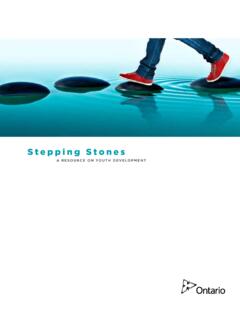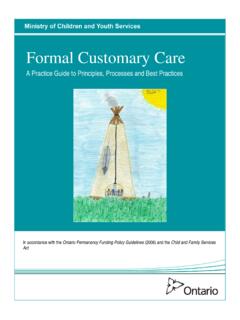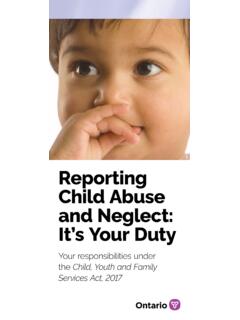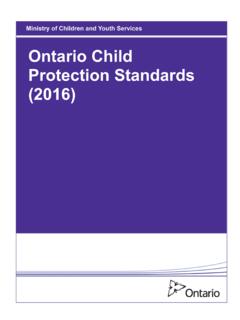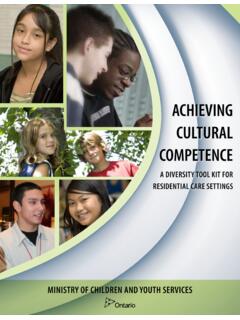Transcription of On My Way: A guide to Support Middle Years Child …
1 OnWayA guide to SupportMiddleYea rsChild DevelopmentThe images used throughout this document were drawn by children who participated in family interviews and focus groups across Ontarioduring the development of On MY Way. The Ministry of Children and Youth Services would like to extend a sincere thank you to all ofthe artists and their families for allowing theuse of their drawings in this more about Child and youth development at 978-1-4868-0533-4 Print ISBN 978-1-4868-0534-1 HTMLISBN 978-1-4868-0535-8 PDF CONtents2 Acknowledgments3 Welcome!3 About this Resource4 Focusing on Middle Childhood5 The Importance of the Middle Years6 Bridging the Early Years and Youth7A Balanced and Wholistic View of Development9 Families Matter9 Respecting Indigenous Perspectives on Wellbeing12 Understanding Development in the Middle Years13 Cognitive Development18 Physical Development25 Emotional Development31 Social Development38 Communication Development42 Mental Health in the Middle Years44 Developmental Maps48 Cognitive Development52 Physical Development 55 Emotional Development59 Social Development64 Communication Development66 Working Together Moving Forward68 EndnotesAcknowledgmentsThe On MY Way resource was developed over the course of a year with Support and input from many people.
2 Including Child development experts, researchers, Indigenous partners, families, community partners, and the ministries of Children and Youth Services; Education; Tourism, Culture and Sport and Health and Long-Term Ministry of Children and Youth Services appreciates the contributions of the organizations and individuals that shared their expertise, perspectives and experiences:FamiliesWe would like to thank the many families across the province that shared insights on parenting children in the Middle Years . The following groups and organizations supported outreach and helped to bring these families together: Bob Rumball Canadian Centre of Excellence for the DeafBoys and Girls Club of Thunder BayBritannia Woods Community HouseCentre Psychosocial d OttawaDilico Child and Family ServicesHalton Multicultural Council ConnectionsToronto Kiwanis Boys and Girls ClubsMerrymount Family Support and Crisis CentreMiddle Childhood Matters CoalitionOntario Inuit Children s CentreBoys and Girls Club of OttawaReach Out Centre for Kids Tungasuvvingat Inuit Weechi-it-te-win Family ServicesChild development experts and authors of Middle Years research papersDr.
3 Chunlei Lu, Brock UniversityDr. Gordon Flett, York UniversityDr. James C t , University of Western OntarioDr. Jan Willem Gorter,McMaster University Dr. Jennifer Connolly, York UniversityDr. Jennine S. Rawana, York UniversityDr. Joel Lopata, Western University, Joel Lopata ConsultingDr. Kate Tilleczek, University of Prince Edward IslandDr. Michelle Jetha, Cape Breton UniversityDr. Sidney J. Segalowitz, Brock University Dr. Susan Scott, Lakehead UniversityEstelle Simard, MSW, RSW, ABD,The Institute for Culturally Restorative PracticesDr. Karen MacLeod, LutherwoodMarni Herold, Lutherwood Dr. Angela Hovey, Lakehead UniversityDr. Les Fleischer, Lakehead UniversityExpert advisorsAndrea Breen, University of Guelph Cindy Blackstock, First nations Child and Family Caring Society of Canada, and McGill UniversityDr.
4 Christopher Mushquash, Lakehead University Dr. Elizabeth Lee Ford-Jones, Hospital for Sick Children and University of To ro ntoDr. Jean Clinton, McMaster UniversityDr. John Cairney, University of Toronto Dr. Kim Schonert-Reichl, University of British ColumbiaDr. Leena K. Augimeri, Child Development Institute (CDI) and University of Toronto Dr. Nancy Young, Laurentian University Dr. Rose Cameron, Algoma University Mary Jo Wabano, Naandwechige-Gamig Wiikwemkoong Health CentreTina Bobinski, Dilico Anishinabek Family CareThe Premier s Council on Youth OpportunitiesIndigenous Partners Anishinabek Nation and the Union of Ontario Indians Association of Iroquois and Allied Indians (AIAI)Chiefs of Ontario Grand Council Treaty #3 Independent First NationsM tis Nation of OntarioNishnawbe Aski NationOntario Federation of Indigenous Friendship Centres Ontario Native Women s Association Ottawa Inuit Children s CentreSix nations of the Grand RiverTungasuvvingat InuitOn MYWay A guide to Support Middle Years Child Development22 Welcome!
5 About this ResourceOn MY Way: A guide to Support Middle Years Child Development is a comprehensive developmental framework to Support children ages 6 12, and is based on up-to-date evidence on Middle childhood an emerging, growing body of research, we know that the Middle Years is a critical period of transition and development with lifelong impacts. However, the body of evidence on Middle childhood development is relatively small compared to that for the early Years (from birth to age six) and youth (ages 12-25). Further, research on development during this period is not as widely and readily available compared to the other resource describes what the leading research tells us about how Middle Years children are changing across Cognitive, Physical, Emotional, Social and Communication domains.
6 It also considers the role that individual self, spirit, context and culture play in influencing these describes what parents, caregivers and other caring adults can do to Support optimal development during Middle childhood, and helps define the most critical opportunities for early interventions that will have an impact on the future. It also supports evidence-based planning and service delivery by community partners, educators, service providers, philanthropic partners, municipal partners, and policy and decision makers all with a shared goal of supporting optimal Middle Years Child development. By working to connect more individuals and organizations with research on what Middle Years children need, we improve our collective ability to effectively Support the wellbeing of our !
7 Who is this for?This resource is intended for all those who play a role in or influence the lives of Middle Years children, including: parents, caregivers and caring adults Elders, Senators* and traditional knowledge keepers ** community leaders and community groups educators and learning institutions agencies and organizations that serve children health care providers planners, policy makers and decision makers philanthropic organizations and individualsHow do I use it? Child development is an interconnected and fluid process. It is experienced through the lens of culture and identity, and influenced by experience and context. As a result, development is best understood and supported with the whole Child in , this resource is intended to be read as a whole.
8 It should be viewed with the understanding that each Child s developmental journey is unique and is shaped by their experience and context, or circumstances. Reading only one section or domain within the document will not present the full picture of how Middle Years children are growing, learning and developing during this reader also needs to keep in mind that Child development is dynamic, and does not move in a straight line. Children move along the developmental continuum at their own pace.* Senators have a special place in M tis culture, the M tis Nation of Ontario and in its governance structure. Highly respected for their knowledge, values, and experience, Senators provide an elder s presence at community events and meetings, and they help to keep M tis culture alive by sharing M tis traditions and ways of life (M tis Nation of Ontario).
9 ** Traditional knowledge keepers include Elders, Senators and other people who pass down knowledge of Indigenous culture and on Middle ChildhoodThe Middle Years refer to the period in life between early childhood and adolescence. Generally, Child development experts consider children between the ages of 6 12 as being in their Middle Importance of The Middle YearsToday s Middle Years childrenOntario is home to more than one million children ages 6 12. This number is expected to increase to million in the next 20 of Ontario s aging population, this group is becoming a smaller, yet ever more important part of our Years children in Ontario today are different from any generation before them. They are growing up in a dynamic time of rapid change. Technology plays an increasingly prominent role in children s lives, and brings with it many new opportunities as well as challenges.
10 Ontario s Middle Years children are very diverse, with 32 per cent identified as being a visible minority and per cent identified as first or second generation most Middle Years children in Ontario are thriving, some children in certain groups face greater challenges than distinct and important stage of developmentThere is new and emerging research that sheds greater light on this important developmental stage. The Middle Years are now understood as a key developmental turning point that set the foundation for personal identity, lifelong skills, habits and childhood is a period when children are exploring who they are and who they want to be, establishing basic skills and health habits, grappling with puberty, physical changes and gender roles, making friendships and forming attitudes about the world they live in, and taking first steps toward independence.
